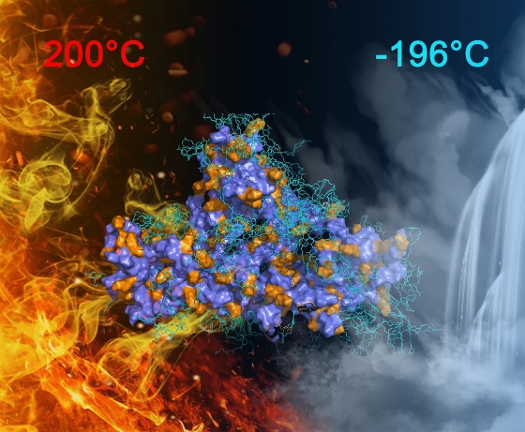 |
| November 08, 2022 | Volume 18 Issue 42 |
Designfax weekly eMagazine
Archives
Partners
Manufacturing Center
Product Spotlight
Modern Applications News
Metalworking Ideas For
Today's Job Shops
Tooling and Production
Strategies for large
metalworking plants
Supramolecular adhesive withstands extreme hot and cold
Researchers have developed a supramolecular adhesive that is recyclable and has outstanding gluing properties across a wide range of temperatures, from liquid nitrogen (-196 C) up to oven-hot temperatures (200 C).
As the team reported recently in the journal Angewandte Chemie, the adhesive gets its efficiency from an exceptionally tight interlocking of the molecular components during curing.

The new supramolecular adhesive has shown impressive properties throughout a wide temperature range. [Image credit: © Wiley-VCH, Angewandte Chemie].
Unlike standard adhesives, supramolecular adhesives do not create adhesion by the molecular components crosslinking with one another. Instead, they form a tight-knit self-assembly during curing, like puzzle pieces fitting together. Researchers are interested in such supramolecular systems because they offer sustainability and customizability and, in principle, the individual starting materials can be recovered again and their chemical behavior can be tailored.
However, to date, the performance of such glues has been decent at best, not to mention highly dependent on environmental conditions.
The new supramolecular glue, developed by a research team headed by Kai Liu from Tsinghua University, Beijing, China, consists of two components, one of which is a small protein that is synthesized in bacteria modified for the purpose. The other component is a crown ether, a ring-shaped molecule that can wrap snugly around another molecule, much like a crown sitting on a queen's head.
The researchers observed this snug interaction between the molecules in their adhesive system. By adding the crown ether and the protein together and heating the solution for curing, the crown ether became anchored to the surface of the protein. The team noted that the protein and crown ether were so tightly bound to each other by their opposing charges and other molecular interactions that they formed a new, interlocking structure that "welded" the proteins together.
The result was an extraordinarily strong adhesive effect. Steel plates glued together withstood high shear forces at room temperature, in liquid nitrogen, and at a temperature of 200 C. The adhesive worked for different materials and under water as well. Such a broad spectrum of working conditions is seldom achieved, even with specialist adhesives, and is certainly a first for supramolecular adhesives. Promisingly, the interlocking components could be broken apart and recycled again, and the reused adhesive lost virtually none of its power.
The researchers say they think one reason for this exceptional adhesive effect, particularly at low temperatures, is a result of the specific supramolecular interactions at play. In particular, the tight interlocking of the components drove water out of the protein. This meant that no ice crystals were able to form when frozen -- as in antifreeze -- which in many conventional glues would lead to premature cracking.
The researchers suggest that this new adhesive could be applied to the manufacture of special parts that will be subject to greatly fluctuating conditions during use; for example, the wide temperature ranges to which spacecraft are exposed.
Source: Wiley-VCH/Angewandte Chemie International Edition
Published November 2022
Rate this article
View our terms of use and privacy policy
